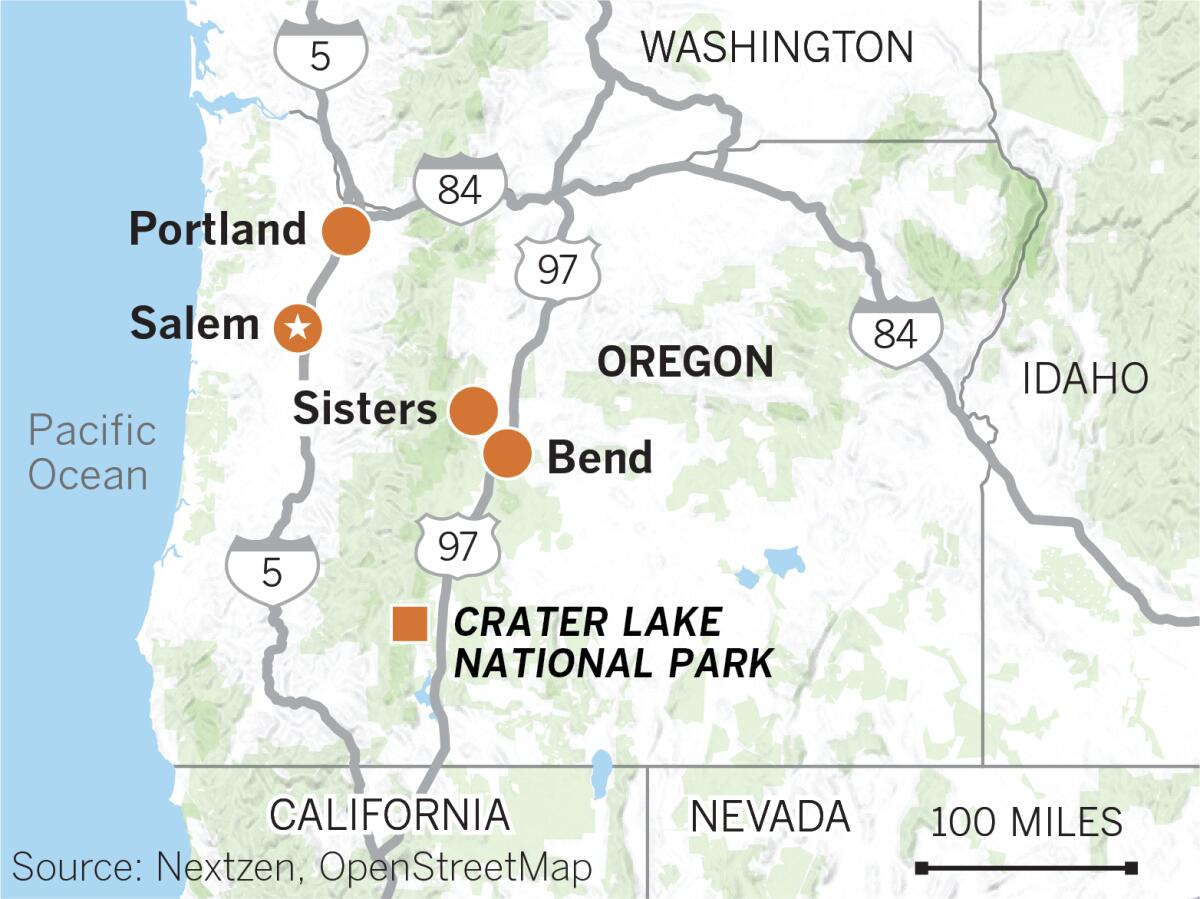A little e-bike cheating makes Oregon Cascades bike tour a gem of a cycling trip
- Share via
BEND, Ore. — At the crest of central Oregon’s 5,325-foot McKenzie Pass, a black-and-gold swallowtail butterfly landed on the handlebars of my bicycle before flitting to my open hand. Perhaps, I thought, it wanted to congratulate me on the 16-mile, 2,143-foot ascent from the town of Sisters through pine forests and thousand-year-old lava flows to the rugged summit.
The butterfly didn’t know I was using an electric-assist bike, which had made the ascent a pleasant experience rather than a sweaty grind. Everyone else in my Trek Travel group, except one woman from Texas, was on a regular road bike and had labored up the climb while she and I cruised, pushed uphill by an electric motor that felt at times like a magic hand on my back.
We weren’t total slackers, however. We had to pedal to engage the bike’s electric motor, which I kept — most of the time — at the lowest “eco” level. Still, I couldn’t help but feel a bit guilty, even if no one else noticed or cared.

In any case, I had a good excuse: A pulled groin muscle had limited my training and still hurt. For the most part, I let myself enjoy the trip, which had started five days earlier at the Oxford Hotel in Bend,where we met our guides, Ashley Hardy and Chelsea Murray, before shuttling two hours south to Crater Lake National Park. I also promised myself I’d return to central Oregon one day to do the electric-assist sections of the bike tour under my own power. (I did pedal two legs in the middle, less hilly part of the ride with a regular Trek road bike.)
Smoke from 2018’s many regional forest fires hung in the air as we approached the park but dispersed as we ate lunch and were fitted to our bikes at the century-old Crater Lake Lodge.
We pedaled off for a 33-mile spin around the nearly 2,000 foot-deep caldera. The ride was more than a little challenging, thanks to the lofty 6,450-foot elevation and the 4,000-foot vertical gain on sometimes steep grades.
But there were plenty of scenic overlooks along the road, including one named for Skell, a spirit god of the Klamath and Modoc people, where we could rest and refuel with snacks from the outfitter’s support wagon.
Better yet, all those pullouts offered stunning views of the crags around the giant lake, which despite its name was not created by a meteor smashing into the Cascades.
Rather, it was formed nearly 8,000 years ago when 12,000-foot Mt. Mazama collapsed after a huge volcanic eruption that scientists say was many times more powerful than the one that blew the top of Mt. St. Helens.
The lake, now filled with rain and snow melt, was the color of deep blue lapis lazuli. By the time we rolled into the lodge to clean up and gather for a glass of wine on the lakeside deck, the smoke was back, turning the sky gray and all but obscuring the caldera.
The next morning, we shuttled north about 90 minutes for a 50-mile ride along the Cascade Lakes Scenic Byway. On the way, we spied Broken Top, the Three Sisters, Mt. Bachelor and other volcanic peaks on the eastern side of the mountain range. From Bachelor, it was a 3,000-foot, 22-mile descent to Bend and its numerous microbreweries.
That afternoon, we decamped and showered at our digs in the Oxford, wandered through Drake Park beside the Deschutes River and dined on Cajun eats at Zydeco Kitchen & Cocktails. I’m pretty sure we all slept well that night.
I abandoned my e-bike the next day and pedaled the relatively easy 22 miles (up and back) to a point near a waterfall on Tumalo Creek. The elevation gain was a manageable 1,350 feet, which one hardy couple from Orange County did twice.
On the fourth day, I again chose a regular road bike to pedal 35 miles from Bend to Smith Rock State Park, a mecca for climbers. The elevation gain wasn’t great, only 1,020 feet, but the 95-degree heat and headwinds flattened me. I still had enough energy, though, to hike the Crooked River Trail below Smith Rock, with Lynn and Greg LaStrapes from Corpus Christi, Texas.
As we walked, Lynn told me that riding an electric-assist bike allowed her to keep up and even pass her husband, who occasionally races, on the three Trek Travel trips they have done.
“Once I tried an e-bike, it made a huge difference in my enjoyment,” said Lynn. “In fact, it was a complete game-changer and made both of us happier.”
Our last two nights were spent at the posh FivePine Lodge in Sisters, about 23 miles northwest of Bend. It was from this base we rode up to the lookout at the McKenzie summit, then flew down the considerably greener, western side of the Cascades to Belknap Springs for a much-appreciated lunch.
My pulled muscle has healed and I’m already planning my training schedule. I’m not sure when I’ll make it around Crater Lake or up and over McKenzie Pass on a regular road bike, but you can bet it’s in my plans.
If you go
More to Read
Sign up for The Wild
We’ll help you find the best places to hike, bike and run, as well as the perfect silent spots for meditation and yoga.
You may occasionally receive promotional content from the Los Angeles Times.






